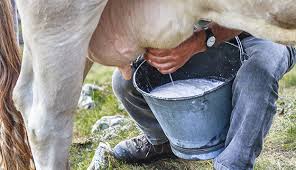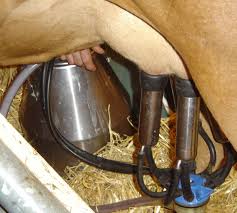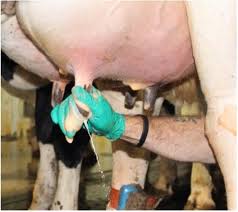The milking process requires several important steps. The purpose of these steps is to elicit optimal milk letdown, minimize the chances of a cow contracting mastitis organisms during milking, and ensure efficient milk removal.
Methods of Milking
Read Also: Importance of a Fish Feeding Point in a Fish Pond
1. Hand Milking

Cows are milked from the left side. After the letdown of milk, the milker starts milking the teats either crosswise, forequarters together and then hindquarters together, or the teats appearing most distended are milked first. A few streams of foremilk from each teat are let onto a strip cup.
This removes any dirt from the teat canal and gives the operator a chance to detect mastitis. Milking is done either by stripping or by the full-hand method. Stripping is done by firmly holding the teat between the thumb and forefinger and drawing it down the length of the teat while pressing it to cause the milk to flow down in a stream. Grasping the teat with all five fingers and pressing it against the palm is another method.
Read Also: When to Feed your Fishes after Stocking
2. Machine Milking

Modern milking machines are capable of milking cows quickly and efficiently without injuring the udder, provided they are properly installed, maintained in excellent operating conditions, and used correctly.
The milking machine performs two basic functions. It opens the streak canal through the use of a partial vacuum, allowing the milk to flow out of the teat cistern through a line to a receiving container. It also massages the teat, which prevents congestion of blood and lymph in the teat.
Advantages of Milking Machine
The advantages of the milking machine are manifold.
- It is easy to operate, costs less, and saves time as it milks 1.5 to 2 litres per minute.
- It is also very hygienic and energy-conserving, as electricity is not required.
- All the milk from the udder can be removed.
- The machine is easily adaptable and gives a suckling feeling to the cow, avoiding pain in the udder as well as leakage of milk.
Do you have any questions, suggestions, or contributions? If so, please feel free to use the comment box below to share your thoughts. We also encourage you to kindly share this information with others who might benefit from it. Since we can’t reach everyone at once, we truly appreciate your help in spreading the word. Thank you so much for your support and for sharing!
Read Also: Trends in Crop Production Nationally and Globally






